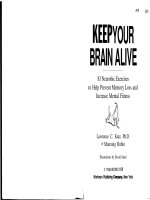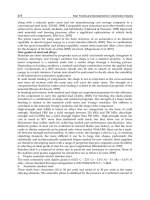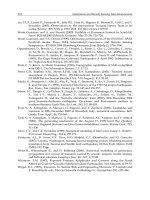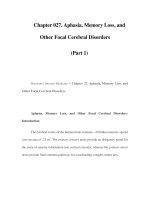Chapter 027. Aphasia, Memory Loss, and Other Focal Cerebral Disorders (Part 12) doc
Bạn đang xem bản rút gọn của tài liệu. Xem và tải ngay bản đầy đủ của tài liệu tại đây (13.71 KB, 5 trang )
Chapter 027. Aphasia, Memory Loss, and
Other Focal Cerebral Disorders
(Part 12)
The patient with an amnestic state is almost always disoriented, especially
to time. Accurate temporal orientation and accurate knowledge of current news
rule out a major amnestic state. The anterograde component of an amnestic state
can be tested with a list of four to five words read aloud by the examiner up to five
times or until the patient can immediately repeat the entire list without intervening
delay. In the next phase of testing, the patient is allowed to concentrate on the
words and to rehearse them internally for 1 min before being asked to recall them.
Accurate performance in this phase indicates that the patient is motivated and
sufficiently attentive to hold the words online for at least 1 min. The final phase of
the testing involves a retention period of 5–10 min, during which the patient is
engaged in other tasks. Adequate recall at the end of this interval requires offline
storage, retention, and retrieval. Amnestic patients fail this phase of the task and
may even forget that they were given a list of words to remember. Accurate
recognition of the words by multiple choice in a patient who cannot recall them
indicates a less severe memory disturbance that affects mostly the retrieval stage
of memory. The retrograde component of an amnesia can be assessed with
questions related to autobiographical or historic events. The anterograde
component of amnestic states is usually much more prominent than the retrograde
component. In rare instances, usually associated with temporal lobe epilepsy or
benzodiazepine intake, the retrograde component may dominate.
The assessment of memory can be quite challenging. Bedside evaluations
may only detect the most severe impairments. Less severe memory impairments,
as in the case of patients with temporal lobe epilepsy, mild head injury, or early
dementia, require quantitative evaluations by neuropsychologists. Confusional
states caused by toxic-metabolic encephalopathies and some types of frontal lobe
damage interfere with attentional capacity and lead to secondary memory
impairments, even in the absence of any limbic lesions. This sort of memory
impairment can be differentiated from the amnestic state by the presence of
additional impairments in the attention-related tasks described below in the section
on the frontal lobes.
Many neurologic diseases can give rise to an amnestic state. These include
tumors (of the sphenoid wing, posterior corpus callosum, thalamus, or medial
temporal lobe), infarctions (in the territories of the anterior or posterior cerebral
arteries), head trauma, herpes simplex encephalitis, Wernicke-Korsakoff
encephalopathy, paraneoplastic limbic encephalitis, and degenerative dementias
such as Alzheimer's or Pick's disease. The one common denominator of all these
diseases is that they lead to the bilateral lesions within one or more components in
the limbic network, most commonly the hippocampus, entorhinal cortex, the
mammillary bodies of the hypothalamus, and the limbic thalamus. Occasionally,
unilateral left-sided lesions can give rise to an amnestic state, but the memory
disorder tends to be transient. Depending on the nature and distribution of the
underlying neurologic disease, the patient may also have visual field deficits, eye
movement limitations, or cerebellar findings.
Transient global amnesia is a distinctive syndrome usually seen in late
middle age. Patients become acutely disoriented and repeatedly ask who they are,
where they are, what they are doing.
The spell is characterized by anterograde amnesia (inability to retain new
information) and a retrograde amnesia for relatively recent events that occurred
before the onset.
The syndrome usually resolves within 24–48 h and is followed by the
filling-in of the period affected by the retrograde amnesia, although there is
persistent loss of memory for the events that occurred during the ictus.
Recurrences are noted in ~20% of patients.
Migraine, temporal lobe seizures, and transient ischemic events in the
posterior cerebral territory have been postulated as causes of transient global
amnesia. The absence of associated neurologic findings may occasionally lead to
the incorrect diagnosis of a psychiatric disorder.
The Prefrontal Network for Attention and Behavior
Approximately one-third of all the cerebral cortex in the human brain is
located in the frontal lobes. The frontal lobes can be subdivided into motor-
premotor, dorsolateral prefrontal, medial prefrontal, and orbitofrontal components.
The terms frontal lobe syndrome and prefrontal cortex refer only to the last
three of these four components. These are the parts of the cerebral cortex that
show the greatest phylogenetic expansion in primates and especially in humans.
The dorsolateral prefrontal, medial prefrontal, and orbitofrontal areas, and
the subcortical structures with which they are interconnected (i.e., the head of the
caudate and the dorsomedial nucleus of the thalamus), collectively make up a
large-scale network that coordinates exceedingly complex aspects of human
cognition and behavior.









